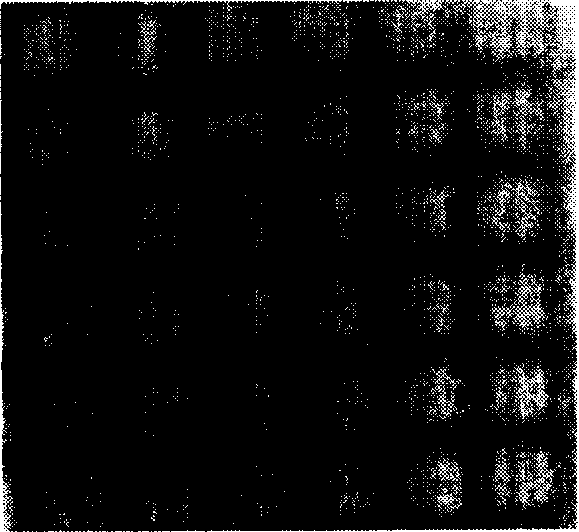Method for manufacturing flawless millipore/mesoporous film by adopting mould plate technique and film thereof
A manufacturing method and crack-free technology, which is applied in the field of crack-free micro/mesoporous film and crack-free micro/mesoporous film, can solve the problems of long roasting stage, inapplicability, and unsolved particle aggregation, etc. Achieve the effect of low temperature and avoid cracks
- Summary
- Abstract
- Description
- Claims
- Application Information
AI Technical Summary
Problems solved by technology
Method used
Image
Examples
Embodiment 1
[0057] 9 (mole, the same below) parts of TPAOH: 25 parts of SiO 2 : 480 H 2 O: 100 parts of EtOH (TPAOH: tetrapropylamine hydroxide, EtOH: ethanol, SiO 2 : tetraethyl orthosilicate) mixed solution was hydrolyzed for 12-48 hours under stirring; then placed in a 60°C water bath for 10-15 days to crystallize, fully washed 4 times with deionized water, freeze-dried to obtain a white powder. The XRD diffraction pattern shows that the white powder is a pure silicon Silicalite-1 nanocrystal with MFI structure, and the average particle size is 60nm.
[0058] Adsorb 60nm Silicalite-1 seeds with MFI structure on the surface of the cleaned α-alumina, and then put 5 parts of TPAOH: 25 parts of SiO 2 : 480 H 2 O: 100 parts of EtOH (TPAOH: tetrapropylamine hydroxide, EtOH: ethanol, SiO 2 : ethyl orthosilicate) mixed solution, crystallized at 100°C, took it out after 3 days, washed the surface of the film with deionized water, and dried it naturally in the air. XRD diffraction pattern s...
Embodiment 2
[0062] Put the cleaned ceramic sheet into 0.14-0.3 parts of CTAB: 7.4-15 parts of NH 4 OH: 1.0 parts of SiO 2 : 70-100 parts of H 2 O(CTAB: cetyltrimethylammonium bromide, SiO 2 : tetraethyl orthosilicate) in the synthetic ratio solution, crystallize at 20-40°C for 10-200 minutes, and obtain a transparent film on the silicon chip. The XRD diffraction spectrum shows that it is MCM-41 with a two-dimensional hexagonal structure (in 1992, Mobil researchers used alkyl quaternary ammonium salt type cationic surfactants as templates for the first time, and synthesized a compound with a single pore size under alkaline conditions. Mesoporous silicate materials, collectively referred to as M41S, including hexagonal MCM-41, cubic MCM-48 and layered MCM-50) mesoporous films.
[0063] Take two pieces of MCM-41 mesoporous membranes with a size of 2×2 cm, put one piece into a horse boiling furnace for calcination, raise the temperature from room temperature to 550 ℃ at a heating rate of 0...
Embodiment 3
[0066] 8.0 parts (TMA) 2 O: 0.22 parts of Na 2 O:Al 2 o3 : 5.0 parts of SiO 2 : 400 copies of H 2 O(TMAOH: Tetramethylamine Hydroxide, SiO 2 : ethyl orthosilicate) mixed solution was hydrolyzed for 12-48 hours under stirring; then placed in a water bath at 60°C for 3-5 days to obtain a white powder. The XRD diffraction pattern shows that it is A-type molecular sieve with LTA structure, and the average particle size is 130nm.
[0067] According to the literature report, adsorb 130nm A-type molecular sieve seed crystals on the surface of the cleaned α-alumina, then put it into the same solution as the above-mentioned synthetic seed crystals, take it out after crystallization at 100°C for 3 days, and wash the film with deionized water Surface, dry naturally in the air. The XRD diffraction pattern shows that the film is a type A molecular sieve with LTA structure.
[0068] Take two pieces of A-type molecular sieves with a size of 2×2cm, and put one piece into a horse boilin...
PUM
 Login to View More
Login to View More Abstract
Description
Claims
Application Information
 Login to View More
Login to View More - R&D Engineer
- R&D Manager
- IP Professional
- Industry Leading Data Capabilities
- Powerful AI technology
- Patent DNA Extraction
Browse by: Latest US Patents, China's latest patents, Technical Efficacy Thesaurus, Application Domain, Technology Topic, Popular Technical Reports.
© 2024 PatSnap. All rights reserved.Legal|Privacy policy|Modern Slavery Act Transparency Statement|Sitemap|About US| Contact US: help@patsnap.com










